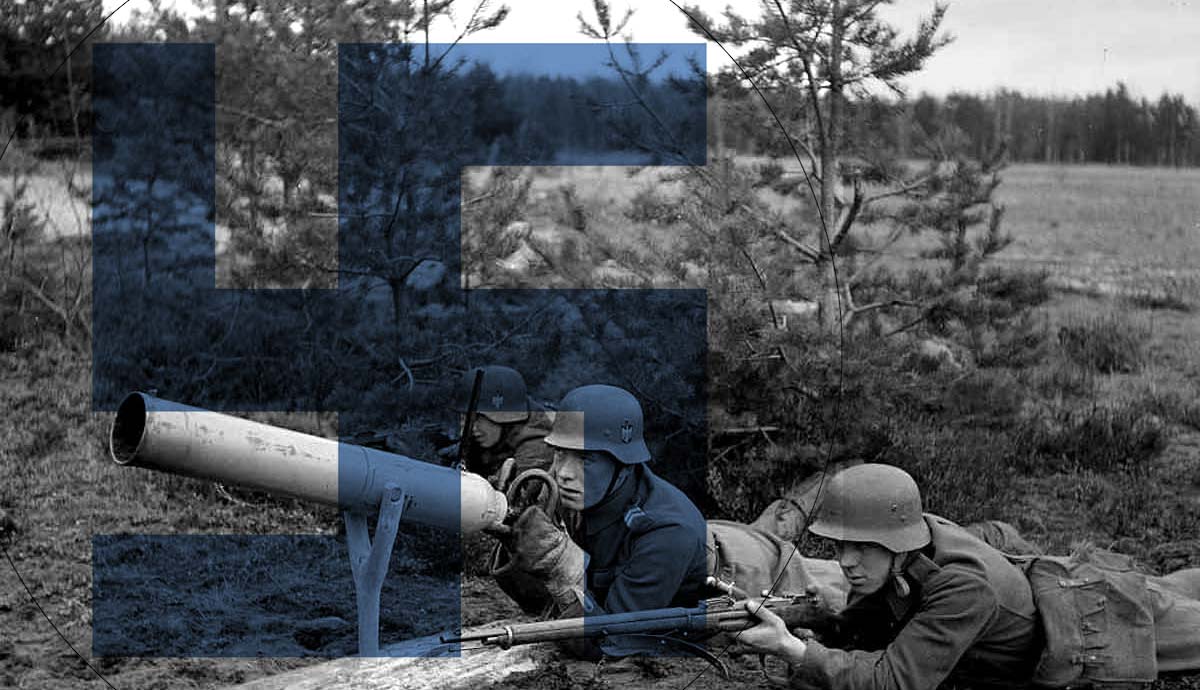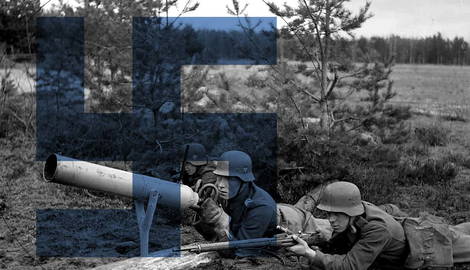
The Axis is generally thought of as a collection of fascist-style dictatorships vehemently opposed to communism and democracy, yet one member of the Axis was actually a presidential democracy.
On the surface, Finland seems to be an unlikely candidate for an alliance with Nazi Germany, but when the strategic and political considerations are taken into account, it becomes apparent why Finland allied itself with Hitler.
Before Germany invaded the Soviet Union, the Soviets invaded Finland, and seeing the potential to harm the Soviets and win an ally in the north, Germany cultivated a friendship with Finland, which was in a strategically very poor position to expect help from democracies in Western Europe.
Finland’s only option was assistance from Germany and an alliance to save itself from Soviet Imperialism.
This is the story of Finland’s role in the Second World War.
The Winter War

Of importance in the relation between the Soviets and the Finns was the demarcation of where the borders between the two countries actually lay. Of prime concern was the Karelian Isthmus, which led from Finland in the north directly to Leningrad. Half this piece of land was under Soviet control, and the Soviets were already concerned that it was too small a piece of land to be a buffer between the two nations. Many nationalist elements in Finland, however, considered it part of Finland and were not happy that the Soviets controlled territory that they believed rightly belonged to the Finns. This was in addition to other disputed areas, including several islands in the Gulf of Finland.
Both countries sought expansion into the other’s territory, but it would be the Soviets who struck first. Diplomatic attempts to resolve the disagreements came to naught, and the Soviets, seeking a pretext to break a non-aggression pact between the two countries, bombed the Soviet small town of Mainila on the border in what would be a false-flag attack.

Finland was heavily outnumbered but put up stiff resistance. Ultimately, on March 12, 1940, the war came to an end with an agreement to cede small portions of territory to the Soviets, as well as allowing the Soviets to construct a naval base on the Hanko Peninsula.
When Germany invaded the Soviet Union on June 22, 1941, the Finns saw their opportunity to expand into Soviet territory, regain what was lost, and capture other claimed territories. Three days later, Finland officially declared war on the Soviet Union and joined Germany’s Operation Barbarossa.
The Continuation War

For Finland, the conflict against the Soviets as part of World War II was known as the Continuation War. Plans were drawn up to expand Finnish territory, and the Finnish armed forces pushed eastwards, achieving massive success with the aid of their Nazi allies.
Under the overall command of General Carl Gustaf Emil Mannerheim, on July 10, Finnish troops began Operation Silver Fox with their German allies, launching offensives along the Karelian front line. Within six days, they reached the northern shore of Lake Ladoga and continued their advance. The success of the German armies in the south shattered the Soviet defenses. Soviet troops along the Karelian front were pulled from combat against the Finns to reinforce the beleaguered Soviet troops facing the seemingly unstoppable advance.
By September 2, the Finns had captured all the area of Karelia that was lost to the Soviets a year earlier. The Soviets were dogged by poor communications, and orders for withdrawal came too late for many of the Soviet defenders. Several divisions found themselves encircled, and tens of thousands of soldiers were captured, along with huge amounts of material.

What remained of the Soviet armies fell back to new defensive positions, while the Germans and the Finns came perilously close to Leningrad. After defeating the Soviets at Porlampi, the Finns decided they had reached their territorial goals northwest of Leningrad for the time being and declined the request to join the Germans in attacking the Soviet stronghold.
Meanwhile, the Finns continued their offensive to the north. In the Karelian region between Lake Ladoga and Lake Onega, the Finns pushed eastwards while the Germans swung around the south of Leningrad and attacked the Soviets from the rear. The Finns made headway, capturing significant amounts of territory, and the Soviets made costly counterattacks that failed. Ultimately, however, the Finns and the Germans were unable to dislodge the Soviets from their final lines of defense. By December 6, the advance had run out of steam, and the Karelian campaign came to an end.

The fighting was bitter and unforgiving, and the Finns and Germans suffered 75,000 casualties, of which a third were killed, while the Soviets suffered 230,000 casualties, 50,000 of which were taken prisoner by the Axis forces. It is unknown how many Soviets were killed in the fighting.
While the Karelian campaign was happening, to the north, more fighting was being waged with the objective of capturing the port city of Murmansk in the Arctic Circle. The German and Finnish offensive was unsuccessful as the rugged Soviet defense kept the invaders in check.
For Lend-Lease, Murmansk was an important corridor through which the Soviets received Western aid, including food, supplies, and material. This Arctic front line would remain relatively stable until late 1944 when the Soviets were on the offensive.
Initial Success

The initial successes of Operation Barbarossa convinced the Finns that the war would be short. President Risto Ryti and the Commander-in-Chief, Gustaf Mannerheim, were popular figures in Finland, and their successes spurred the Finnish people on. There were, of course, detractors to expansionist ideas, but it was envisioned that Finland would annex the entire Kola Peninsula and create a very short, easily defensible border with the Soviet Union or whatever remained of it. Mannerheim used the slogan, “Short border, long peace.”
When Finnish troops went beyond their 1939 borders and started conquering Soviet territory, there were major elements that questioned the intentions of their government, and there were soldiers who questioned their orders. Some saw their democratic government as moving closer towards their fascist ally, which had been stressed to be a “co-belligerent” rather than an actual ally.
Britain declared war on Finland on December 5, and British commonwealth countries followed with their own declarations soon after. Aside from a few small military actions, this declaration was mainly for show. Britain neither wanted to be at war with Finland nor did it see the Finnish government as being a particular threat. Finland was a democracy in a difficult strategic position, and the British understood the difficulty of the Finnish predicament. For the British, however, their own alliance with the Soviet Union was of prime importance to defeating the Nazis.
The War Continues

From 1942 onwards, a prime focus for the Finnish army was the siege of Leningrad, although the extent of Finnish involvement has been a topic of debate. While some historians claim the Finnish supported the German policies of starvation, others have lessened the impact of the Finnish contribution by stating the Finns simply dug in and held their lines while letting the Germans commit to the unpleasant work of warring against civilians.
In June 1942, Hitler requested that Finnish troops aid the Germans in assaulting Leningrad, but Mannerheim flatly refused, stating that the Finns had reached their own objectives and had no need to provoke the Soviets further. This action supports the claim that the alliance was one of convenience rather than that of common ideology.
Over the next few months, the military situation turned from victory to one of major concern for the Finns as the Soviets began to operate with more confidence, securing victories. Finnish and German attempts to cut supplies into Leningrad began to be successfully challenged.
The situation became critical in 1943 as the Soviets completely halted the German advance and began to launch counter-offensives of their own, achieving significant success. The Battle of Stalingrad was a major turning point in the war, and the Battle of Kursk in mid-1943 solidified the inevitable German defeat. From that point on, it was only a matter of time before the Soviets would take the initiative against Finland too. Finland thus began to search for a way out of the war, and peace talks were held between Finland, the Western Allies, and the Soviet Union.

These attempts at peace, however, proved difficult to negotiate, and Stalin decided it was better to continue the war to force Finland to surrender. The Soviets intensified the bombing of Helsinki and advanced up the Karelian Isthmus towards the 1940 Finnish border in an operation that coincided with the D-Day Landings in Normandy.
In August 1944, President Ryti resigned and was replaced by Gustaf Mannerheim. The Moscow Peace Treaty was signed on September 19, 1944, with Finland agreeing to return to the 1940 borders as well as the ceding of the city of Petsamo and the payment of the equivalent of $300,000.
Of critical importance to this treaty was Finland’s acceptance of breaking diplomatic ties with Germany and expelling German troops from the country. The Germans attempted to withdraw from the north of Finland into Norway, but the withdrawal was taking longer than expected, and the Finns, under pressure from Moscow, reluctantly attacked the Germans over the course of the next few months in a series of minor battles. The Finns regarded this conflict as the “Lapland War,” and it claimed the lives of around 1,000 Germans and 700 Finns.
Democracy & Nationalism

Despite the Finns’ reluctance to ally themselves ideologically with the Germans, they did have a sense of nationalism that turned particularly ugly after the Finnish capture of the Karelian Isthmus.
The Finnish wanted to expel the remaining Soviet citizens, mainly older women and children. Concentration camps were set up, and these people were subjected to harsh treatment in the form of starvation. Despite the conditions, it was not wholly the wish of the Finnish people to be so barbaric. Poor harvests in Finland had made the situation difficult for everybody, but the situation in the camps was far worse. After hearing of the disproportionate loss of life in the camps compared with the rest of the country, the Finnish government addressed the imbalance and improved the situation in the camps. Mannerheim then called on the Red Cross to inspect the camps.

Finland’s participation in the Second World War was a result of a desperate and unfortunate situation of national survival. It was subject to Soviet aggression, German pressure, and a complete lack of the capability to gain support from the Western Allies because of its geographical position.
Finland’s alliance with Germany is generally seen as being done with reluctance. Not powerful enough to stand on its own, Finland fought for recognition while being used as a pawn by far more powerful entities.










